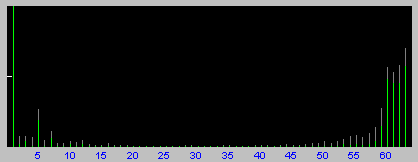|
Noise, especially continuous e.g. switching or brush noise, is reasonably easy to detect with modern instruments – but not by design yet rather by a flaw they all have! The flaw is the common Fast Fourier Transform (FFT) method used for deriving harmonics from an injected waveform. Less expensive instruments may perform the FFT only every nth cycle (because of limited microprocessor power), but they too show what we're after.
Above is the typical "bathtub" style harmonic spectrum indicating the presence of, in this case, switching noise. The FFT process takes the noise to be, rightly so, high-frequency content; It just makes the mistake of trying to indicate this as a specific frequency (which is usually totally unrelated to the actual noise frequency!). A highly defined bathtub, as shown, tends to indicate repetitive switching noise that occurs at the same place on the cycle. A less defined bathtub will indicate a more erratic noise e.g. that which would come off a set of ill-fitting brushes or slip-rings on a motor. When the peak (grey) and average (green) bars have a large difference it usually indicates the noise is intermittent (kind of logical!).
Such things don't come without a catch, especially when readings like this are actually as a result of a flaw rather than by design! The harmonic spectrum must never be taken to indicate the frequency content of the noise itself – only that noise is present. Most power quality instruments have low-pass filters (very high frequencies are not let through) that will inherently 'smooth' the waveform before displaying it to the user. One needs to use application-specific high-speed oscilloscopes and/or other fancy gear (coupled with years of experience) to assess the true frequency content of any noise and the extent to which it will affect sensitive devices subjected to this noise.
© 15.06.04 |
 INTERPRETING THE READINGS:
INTERPRETING THE READINGS: